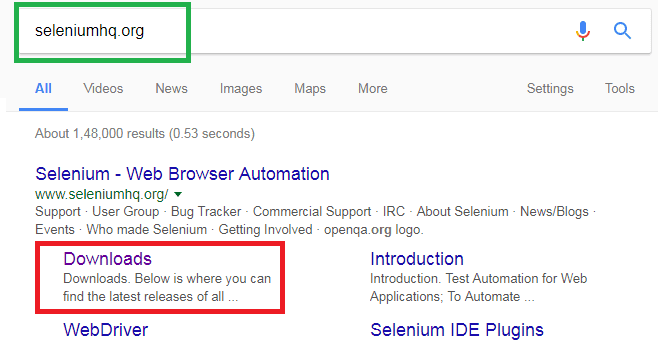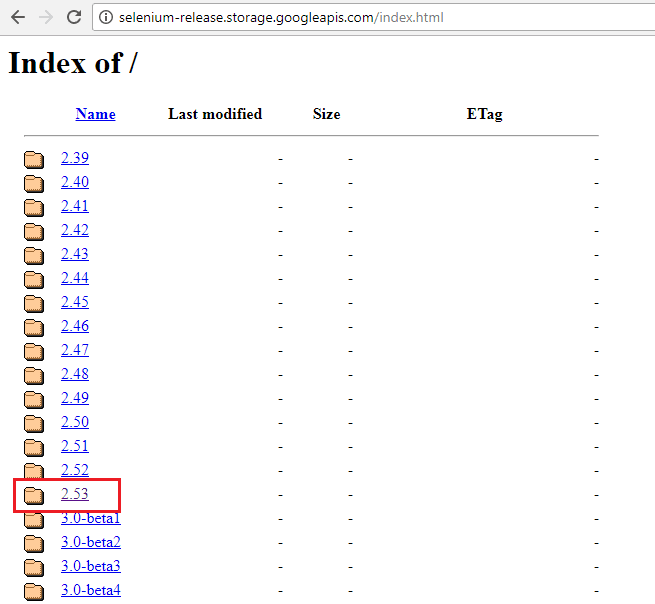

- #SELENIUM STANDALONE SERVER 2.53.1 DOWNLOAD INSTALL#
- #SELENIUM STANDALONE SERVER 2.53.1 DOWNLOAD DRIVER#
- #SELENIUM STANDALONE SERVER 2.53.1 DOWNLOAD DOWNLOAD#
Do you? The commits and committer information should be easy once the source files are located. I don't know enough about Java to be able to trace back from 'selenium-html-runner-3.4.0.jar' to the relevant files in the repo. This port is where the other Selenium nodes will have to connect to, to register themselves to the Selenium Hub and be part of the grid. As a Hub, it will listen on port 4444 on your local computer. You should see INFO - Launching Selenium Grid hub. Maybe picking through the commits, to find the contact information for recent and frequent committers to HTML Runner and asking them directly would be a good way to get a qualified answer. java -jar selenium-server-standalone-2.53.1.jar -role hub. I suppose we should start by getting a qualified answer to whether (and where, my original question) the documentation for Selenium HTML Runner exists. If there *is* documentation, but it's missing parts, we could optimize our time-spend by writing PR's against it.īut, if there is documentation, and we start working on this without reviewing it, at least some of our time will be wasted. If there's no documentation for HTML Runner, then we could do that and it would be a great way to contribute to the Selenium project (if the maintainers accept the contrib). maybe "try" would be a better word, setting more appropriate expectations. If there *isn't* any documentation, it seems premature for to say: "To run Selenium tests exported from IDE, use the Selenium Html Runner." Because, at least for me and my use cases, without documentation, it's not possible to use it. 'results.html' looks like a file, but it's a directory.
#SELENIUM STANDALONE SERVER 2.53.1 DOWNLOAD INSTALL#
How do I "hit enter" in a way that works in both interpreters? An 'HTMLSuite' page without a path gets interpreted as a page in 'baseURL'. Install and configure Selenium Standalone Server You can skip this part and jump strait to the iOS example if you are familiar with NightWatch web testing, but it is a good refresher and way to confirm all standard UI testing works. What are the valid values for '*browser'? What are the dependencies? How do I handle common errors? One of my Selenium IDE actions is to "hit enter on the keyboard", but it's not working in HTML Runner. I have lots of questions that the documentation might answer, and have made discoveries by my fumbling attempts to use the tool that the documentation might have helped me avoid or understand. I had found that, but it's not sufficient. In addition, if we want to start browser instances at the port 5557 we can specify that in the above command.Thank you for attempting to be helpful. Also, notice that we can choose the port number for the node.

java -jar selenium-server-standalone-2.53.1.jar -role hub.

Once the file is downloaded you can start with hub creation.
#SELENIUM STANDALONE SERVER 2.53.1 DOWNLOAD DOWNLOAD#
Since we have customized, we can notice in the above figure that 2 firefox browser instances and 2 internet explorer instances are registered with the node. If you do not have selenium server then you can download from their official site. > java -jar selenium-server-standalone-2.53.1.jar -role node -hub -port 5555 -browser browserName=firefox,maxInstances=2 -browser browserName=iexplorer,maxInstances=2
#SELENIUM STANDALONE SERVER 2.53.1 DOWNLOAD DRIVER#
For example, If we want to launch 2 Firefox and 2 internet explorer instances for testing.īelow is the command to customize the instances. We give a quick overview of two web drivers, HtmlUnit Driver and Gecko Driver, that work work with Selemium, allowing web devs to create dynamic web pages. In addition, we can also customize the browsers and the no of instances we need for testing. > java -jar selenium-server-standalone->.jar -role node -hub As a result, to check the node status, visit in the browser.


 0 kommentar(er)
0 kommentar(er)
